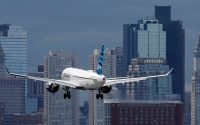Sailor’s Remains Identified 82 Years After Pearl Harbor
On Dec. 7, 1941, the U.S.S. California, the flagship of the Navy’s Pacific Fleet, was moored on “battleship row” at Pearl Harbor when it was struck by Japanese torpedoes and bombs. The ship caught fire, flooded and sank over the course of three days, and 103 crew members were killed.
Officials were initially unable to identify all of the victims and the remains of 25 “unknowns” were buried in Hawaii.
But on Thursday, officials announced that they had used advanced forensic technology to identify one of them as David Walker, a 19-year-old mess attendant third class from Norfolk, Va.
“It is our duty to bring them home,” said Sean Everette, a spokesman for the Defense P.O.W./M.I.A. Accounting Agency, or D.P.A.A., an arm of the Pentagon whose mission is to find and return missing military personnel. “It’s a promise fulfilled to the service member,” he said, adding that “we also owe it to the families to give them answers.”
Mr. Walker, who attended high school in Portsmouth, Va., before he joined the Navy, will be buried at Arlington National Cemetery in September, officials said.
A marker signifying that he has been accounted for will be placed next to his name on the Walls of the Missing at the National Memorial Cemetery of the Pacific in Honolulu.
His remains were identified in November, officials said, nearly 82 years after the surprise attack on Pearl Harbor brought the United States into World War II, and six years after the D.P.A.A. exhumed the remains of the 25 “unknowns” connected to the U.S.S. California.
Officials said this week that scientists from the agency used anthropological and dental analysis to identify Mr. Walker. Scientists from the Armed Forces Medical Examiner System also used mitochondrial DNA analysis.
As a mess attendant, Mr. Walker, who was Black, would have been responsible for running the ship’s galley, or cafeteria, Mr. Everette said. Mess attendants cooked, served food and cleaned dishes.
“There were only a handful of jobs that were open to African American service members in the Navy, and mess attendant was one of them,” Mr. Everette said, adding that “unfortunately, back then, the Navy was still segregated.”
The D.P.A.A. identified Cheryle Stone, 70, as Mr. Walker’s next of kin. Ms. Stone, who lives in Pennsylvania, said that Mr. Walker was a cousin who died long before she was born.
She said she learned about him for the first time when the D.P.A.A. contacted her. She immediately thought about his mother, she said in an interview, and how hard it must have been for her to not know what had happened to her son.
“That had to be horrible,” Ms. Stone said.
Ms. Stone said she also imagined her cousin’s experience aboard the U.S.S. California as one of the few Black service members.
“I think that he would have had to have been a very strong person,” she said.
Mr. Walker is one of five sailors from the U.S.S. California whose remains have been identified since 2018.
In January, officials identified the remains of Merle C.J. Hillman, 25, a pharmacist mate second class from Holyoke, Mass. Officials said scientists used anthropological, mitochondrial DNA and Y chromosome DNA analysis.
Last year, officials identified the remains of Stanley C. Galaszewski, 29, a seaman second class from Steubenville, Ohio. In 2022, two other sailors from the California were identified: Pete Turk, 20, a seaman second class from Scammon, Kan., and Tceollyar Simmons, 18, a seaman second class from Detroit.
While the effort to identify more sailors from the U.S.S. California attack continues, similar projects have been halted.
The military announced in 2021 that it was ending a six-year project to identify the remains of those killed on the U.S.S. Oklahoma during the Pearl Harbor attack.
Officials were able to match human remains from the ship with the names of 362 sailors and marines. Thirty-two members of the ship’s crew could not be identified in the project, and were interred at the National Memorial Cemetery of the Pacific.
Though the Oklahoma project ended, officials said at the time that separate efforts to identify crew members of the U.S.S. California and the U.S.S. West Virginia would continue.


